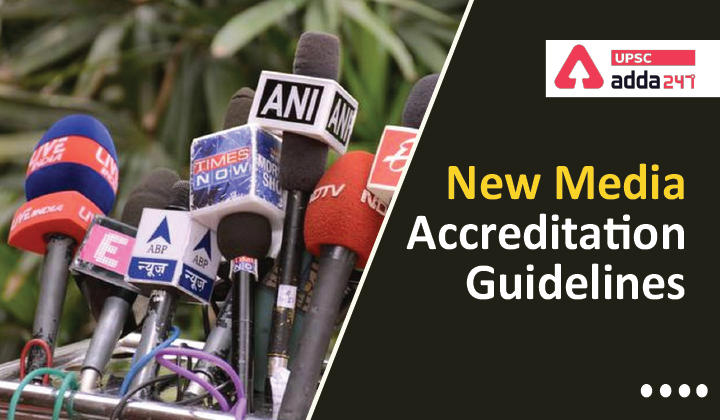Table of Contents
Central Media Accreditation Guidelines 2022: Relevance
- GS 2: Government policies and interventions for development in various sectors and issues arising out of their design and implementation.
Get Free Study Material for UPSC and State PCS Examinations
Central Media Accreditation Guidelines 2022: Context
- Recently, the Union Ministry of Information and Broadcasting has released the Central Media Accreditation Guidelines-2022, whereby it has given certain conditions under which the accreditation o a journalist will be withdrawn or suspended.
Provisions under which a journalist’s accreditation may be withdrawn
- The Central Media Accreditation Guidelines-2022 have outlined the conditions for withdrawal of accreditation if a journalist acts in a manner prejudicial to the
- country’s security, sovereignty, and integrity
- friendly relations with foreign states,
- public order or is charged with a serious cognisable offence.
- Most of the provisions are drawn from Article 19(2) of the Constitution which are understood to serve as guidelines for the press and media.
Central Media Accreditation Guidelines 2022: How is it different from the past?
- Critics are saying that the guidelines are more in the nature of proscriptions rather than prescriptions.
- In laying down the conditions for withdrawal of accreditation, these guidelines serve more as censorship rules rather than guidelines.
- Previous guidelines were more general in nature and did mention that accreditation would be withdrawn if found to be misused.
- In the new guidelines, however, there are 10 provisions under which accreditation to a journalist can be withdrawn.
Central Media Accreditation Guidelines Implementation
- As per the guidelines, the Government of India shall constitute a committee called the Central Media Accreditation Committee chaired by the Principal DG, Press Information Bureau (PIB).
- This committee will comprise up to 25 members nominated by the Government to interpret the guidelines for withdrawal of accreditation.
Central Media Accreditation Guidelines 2022: Criticism of the guidelines
- Deteriorating ranking in press freedom: In 2020, Reporters Without Borders (RSF) ranked India 142nd among 180 countries on the World Press Freedom Index 2020.
- Against the constitutional right of free media: The guidelines carry the threat of coming in the way of the functioning of a free media.
- Though freedom of the press is not explicitly stated in the Constitution, the ambit of freedom of expression under Article 19 of the Constitution has been generally interpreted as having laid down the template for a free press in the country with subsequent pronouncements of courts ensuring it.
- Risk of delegitimising reports: The reports, especially of an investigative nature, critical of the Government could now be seen as prejudicial to the interests of the country and it will be left to the interpretation and discretion of the Central Media Accreditation Committee to read the guidelines and decide what is defamatory while denying accreditation to a journalist.
Media regulation in India: Accreditation of a journalist
- A journalist with a minimum of five years as a full-time working journalist can apply for accreditation to the PIB, after being thoroughly checked by the Ministry of Home Affairs.
- Any journalist working with a newspaper which has a daily circulation of 10,000; news agencies with at least 100 subscribers and digital news platforms with 10 lakh unique visitors can apply.
Importance of accreditation
- Accreditation helps in access to government offices and to special events and functions organised by the Government of India.
- Some Ministries like Home and Defence and Finance allow access only to accredited journalists.
Previous attempt to regulate the media
- Defamation Bill in 1988 is the most infamous proposal to control the press before the advent of private news channels. Under pressure from a unified media and several sections of the public, the Bill was withdrawn.
- State Governments like Kerala and Rajasthan had come out with their own versions of proposed rules which were withdrawn under pressure and criticism.
- In 2018, the PIB (under I&B Ministry) had proposed a Fake News Guidelines under which accreditation could be cancelled if the journalist was seen as peddling content that was fake. The order was withdrawn under pressure.
- More recently the Government proposed a series of rules under the IT Act to check digital news content.
Also Read:





 TSPSC Group 1 Question Paper 2024, Downl...
TSPSC Group 1 Question Paper 2024, Downl...
 TSPSC Group 1 Answer key 2024 Out, Downl...
TSPSC Group 1 Answer key 2024 Out, Downl...
 UPSC Prelims 2024 Question Paper, Downlo...
UPSC Prelims 2024 Question Paper, Downlo...




